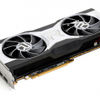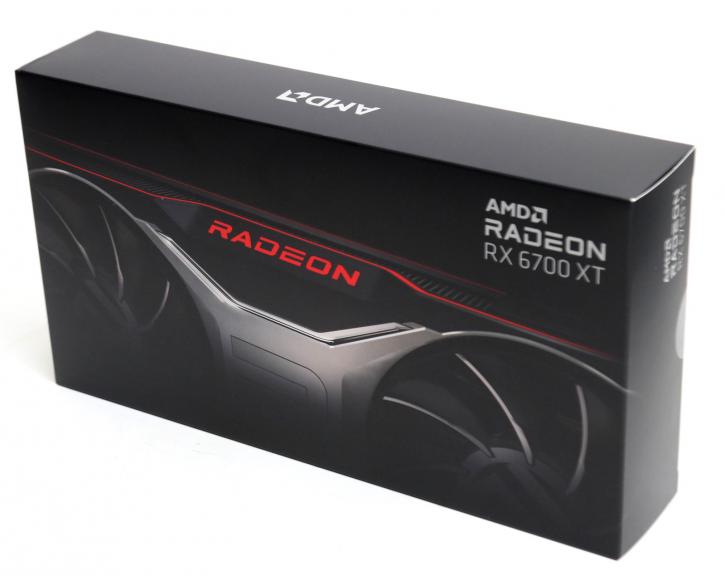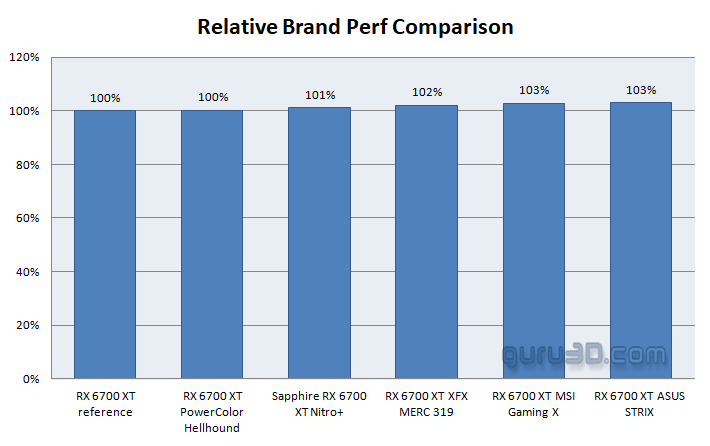Final words and conclusion
Final words
You know, the Radeon RX 6700 XT is a lovely little card in that WQHD (2560x1440) resolution domain for gaming; however, too expensive? We've seen incredible price hikes in the past two years where mainstream series graphics cards have been repositioned as high-end ones, with accompanying price levels. NVIDIA has started that trend, and where AMD always had a little more value to offer this year, that tide has turned. It might be so that the reference RX 6700 XT sits close to RTX 3060 Ti and sometimes 3070 performance, but only in shading performance. Raw Raytracing performance is a notch slower than the competition offers. We can also not apprehend that AMD still has not implemented any form of machine learning super-sampling dedicated in hardware, much like NVIDIA offers Tensor cores. For these two reasons (RT perf and lacking MLAA), we cast doubt as to why AMD is trying to justify that starting price of 479 USD. The true competitor here is the RTX 3060 Ti with its 399 USD MSRP. We'd like to remind AMD that NVIDIA introduced its Tensor cores back in the summer of 2018, yet still has no to that technology answer implemented. You can also argue that while the Infinity cache works most of the time, it's designed to be a workaround to fill an imperfection in the choice of a more affordable memory type (GDDR6 opposed to GDDR6X), the current AMD GPUs are memory bandwidth deprived, even with GDDR6 at 16 Gbps, but more so due to the 192-bit wide memory bus. And that's going to bite this product in the ass every time you get GPU limited, or the L3 cache runs out and gets fewer hits.
So what am I trying to say here? Well, of course, AMD can opt for a different route in architecture, even with valid reasoning. They dismiss MLSS/DLSS, the somewhat dim Raytracing performance, and then limited memory bandwidth. Really that's fine up to a certain point. But what you then as a company cannot do is to price hike your product like that. Performance overall from the rasterizer/shading point of view in that WQHD domain is absolutely lovely, make no mistake .. but that starting price of 479 USD for a graphics card aimed at the WQHD resolution domain is the biggest obstacle this range will face.
FidelityFX Super Resolution?
Now, coming back from the previous chapter. AMD has been planning its own DLSS counterpart called FidelityFX Super-Resolution for a while. Unfortunately, even when the new Radeon RX 6700 XT was presented to the media, there is no new information or timeline on this, 'we're working on it' is the only thing you'll get back from AMD as an answer. The supersampling technology from AMD will get available once it is ready for use on all current GPUs - including those that are in the PlayStation 5 and consoles Xbox Series X | S work. However, AMD still faces the fact that they do not have dedicated processing cores to do so. So whatever they do, they need to run over the existing compute engine hardware. Hopefully, their alternative will work well and come out sooner rather than later. But it leaves open this technology 'until announced,' risking being too little too late.
Smart Acces memory
A recent ability that AMD made available and a trick that is now passing onwards to intel and NVIDIA as well is SAM. Smart Access memory is able to boost your framerates a bit further, sometimes significantly, sometimes a little, sometimes not at all. SAM requires that CSM Support is turned off in the BIOS in order to enable the above 4G Decode, which will allow Resizable Bar Support (SAM) to be enabled. The problem here is that if your Windows installation is configured as non-UEFI, Windows will be unable to boot from your currently installed SSD/HDD. Most PCs will be configured like that. The only solution is to disable CSM and reinstall Windows 10 to get this feature-set supported or perform some really advanced trickery. That said, SAM is not yet 100% stable, especially swapping out cards with another one (some we as reviewers do a lot), which can end up in black screens. The only solution then is the clear CMOS and start configuring from scratch.
Also, from an editor/reviewer point of view where an objective equal playing field is mandatory, one question keeps popping up in my head; is it really fair to compare some products with the technology-enabled and others disabled? We're still fighting that dilemma a bit.
Performance spread reference and AIBs
We've been quite busy the past week or so as we have lined up six Radeon RX 6700 XT reviews, actually seven, but we're still awaiting a sample. So from top to bottom, the differences certainly are not huge, have a peek:
So the chart above is arbitrary in the sense that results can differ a single % here and there, less so in fillrate limited situation, more so in GPU bound situations. But from reference to the fastest AIB cards, you're looking at 3 to maybe 4% differentials (depending on game and resolution). So you need to weigh in if the additional 3% (that's 3 FPS on a 100 FPS average) is worth a steep 100 USD AIB premium, as yes, we do expect some board partner product to be priced in the sub-600 USD domain.
Cooling & acoustic
The 6700 XT reference product, much like its bigger siblings, offers good results, even in stressed conditions, all thanks to the dual-fan cooler. You'll be hard-pressed to hear the card. AMD certainly has improved in this respect over the previous-gen products. the GPU under the hood capable of producing 230W of heat in a default configuration, so likely the cooler has a 300W thermal power design. We're looking at 39~40 DBa values under load and temps closer to the 80 Degrees C range, all okay. Board analysis also shows all critical components are tied to some form of cooling. FLIR imaging shows the card is hardly bleeding heat. Overall, we're very comfortable with what we observe. The 40 DBa remains to be silent, as the acoustic output hardly can be heard; this is the tricky thing to explain as sometimes the measurements do not match with what you can hear with your own ears.
Energy
Heat output and energy consumption are closely related to each other, as (graphics) processors and heat can be perceived as a 1:1 state; 250 Watts in energy consumption approaches close to 250 Watts in heat as output. This is the basis of TDP. AMD is listing the card at 230W, which is okay at best for a graphics card in the year 2021. We measure numbers slightly under the XT's advertised values; we measure the entire power consumption of the card to close in at 220 Watt.
Coil whine
The 6700 XT, much like any other card these days, does exhibit coil squeal, more so than normal. Is it annoying? Well, it's certainly at a level you can hardly hear it. In a closed chassis, that noise would fade away in the background. However, with an open chassis, you can hear coil whine/squeal. Graphics cards all make this in some form, especially at higher framerates; this can be perceived.
Pricing
We feel we have been discussing this enough already, of course, and think the 6700 XT priced way out of the comfort zone it needs to be. AIB products will undoubtedly pass the 500 even 550 USD marker, which hardly makes any sense for a product aimed at a WQHD monitor range competing with the 399 USD GeForce RTX 3060 Ti and maybe GeForce RTX 3070. Genuinely, we feel this should be a sub 350 USD product. Follow the product line back to say Polaris, 6700 XT ($479), 5700 XT ($399), RX570 ($179), RX470 ($179), R9 270 ($179 USD), now that is not a 100% fair comparison, but see what's happening there? WQHD cards always have been at that 200~250 USD range and marker, just a few years ago.
Tweaking
The RX 6700 XT likes more memory bandwidth. You can add it, up to 17.2 Gbps; AMD enforces limits on the memory subsystem, limiting your GDDR6 memory that maximum overclock. We don't like that as we feel we could have gone a notch further. Results will vary per board, brand, and even card due to cooling (GDDR6/GPU/VRM). GPU tweaking wise we'd reach a really proper 2750~2800 MHz on this AMD Navi GPU. That's without anomalies and crashes whatsoever. Depending on load, game/app, and board assigned power, we now see the dynamic clock frequency hovering in the 2700~2750 MHz range. That's impressive. As always, all that tweaking and extra energy consumption will bring you maybe ~5% extra performance at best (depending on your results). For our overclock to be successfully listed here, it needs to pass 4 game runs (different games) in Ultra HD to be deemed stable.
Conclusion
The base design of the RX 6700 XT is excellent; AMD has made choices in the memory subsystem offering them restricted memory bandwidth, adding L3 cache they are bypassing the bulk of that challenge, and that works up-to 2560x1440 indeed; however, the L3 cache will always be a bypass, a limitation even as with future more GPU bound games, you're prone to run out of that cache and get a full penalty of that 192-bit wide memory bus. Raytracing is at a level where you can 'play around with it, but AMD is not at the perf level of its competitor. The most prominent miss for AMD is lacking some sort of DLSS. Make no mistake; all factors combined still make it a tempting and lovely product in that 2560x1440 domain; if it hadn't been priced so high. At the very least, the product would have had to be under a 400 USD marker, sub-350 USD in my judgment. I know; you can argue and disagree with me. Sometimes, the card is as fast or a bit faster than an RTX 3070; this product will mostly compete with the $399 3060 Ti. And you need to realize that for the 20 bucks, you can get that GeForce RTX 3070. Especially in Ultra HD and future GPU-bound games, this offers more merit. GeForce RTX 3060 Ti / 3070 as well can be lackluster with hybrid raytracing; however, the DLSS combo will get you far better performance in raytracing and (RT) on the green side already is faster already with its 2nd generatioN RT cores. Concluding, we already felt the RTX 3060 Ti and RTX 3070 to be overpriced; however, either one would be the better buy. The Radeon RX 6700 XT remains to be a fun card series for gamers that's solely focused on rasterized shading; at Full HD and WQHD, the 96MB L3 cache does its magic, for now, it can be tweaked a fair notch, and you can play around with raytracing a little bit. But that price tag ... yeah, I don't know what else to say here.
Sign up to receive a notification when we publish a new article.
Or go back to Guru3D's front page.
- Hilbert, LOAD"*",8,1.



